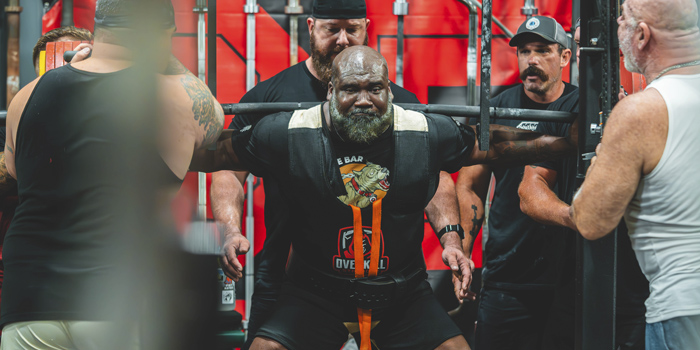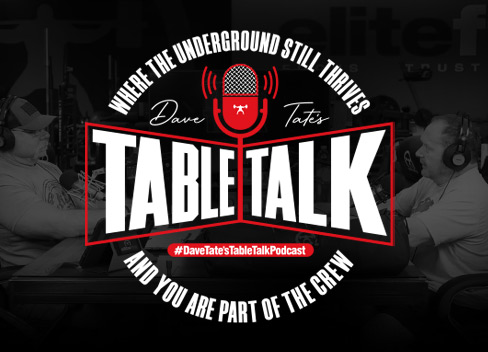
The global totality and granular nuance of his life’s strength and power journey made Ernie Frantz worthy of being one of the legendary faces on powerlifting’s Mount Rushmore. One shining example was being powerful enough to win a World Powerlifting Championship and be muscular and cut enough to place second in the Mr. USA, all on the same day.
I will spare the enormity of his accomplishments, as that would be an article in and of itself. Instead, to summarize, at 198 pounds, Ernie Frantz deadlifted 777 pounds on a stiff 1970s barbell and, at any given moment, had a physique and muscularity of that era that was never more than 16 weeks from being stage-ready. Some of his powerlifting records still exist (even as lifting gear has increased totals), and his physique was featured in IronMan magazines in the late 1970s, as he was the Mr. USA runner-up twice.
Ernie's Thoughts on Hypertrophy
Ernie Frantz was a believer in, and a disciple of, pure unadulterated power. Additionally, he was also a systems thinker. Ernie understood that to be fully powerful, a powerlifter needed to also engage in hypertrophy training at times. Hypertrophy, as muscle built only via the three primary power lifts and a few other primary compound power movements, means that the lifter was leaving unrecruited muscle, ancillary strength, and stabilizing power on the table. The type of muscle, strength, and power that can only be developed through multiple sets of multiple reps to the point just before, right at, or slightly beyond muscular failure.
Ernie would say that to be the best powerlifter or the best bodybuilder would ultimately require a choice between the two. He taught and wrote about how trying to simultaneously build championship power for powerlifting and championship muscularity for bodybuilding does not mix, and to be great at one or the other requires a choice between the two. But, he would also teach that hypertrophy is an aspect or a module of powerlifting training, that is, something that when engaged in, has value, merit, and worth.
Building Power and Building Muscle
The nuance of blending building power and building muscle is not the on-off nature of the toggle switch but more so the subtlety of a volume knob. Ultimately, the symbiosis of a full range of movement of the muscle in the hypertrophy movements and rep ranges to enhance one’s powerlifting, opens new levels of strength and performance as well as resilience against injury.
A full range of movement and a higher rep range would serve to bring both blood and healthy stress to tendons, ligaments, and other areas. Areas that sheer ballistic power and explosiveness in powerlifting can stress to the point of detachment when ancillary aspects of the body are neglected. This is a fundamental lesson in every powerlifter and strength athlete's journey of power and the lesson I want to impart to you.
As powerlifters, it behooves us to engage in hypertrophy for the greater good of our holistic powerlifting training. There are times after training for, and competing in a meet, when it is a very good idea to back down from the 4-3-2-1 rep scheme and enter the land of the 8-10-12-15, and sometimes higher rep range, depending on the muscle or muscle group being trained. There is also a high value to having an amount of hypertrophy built into a strength and power-based program.
Power Training vs Bodybuilding Competition
That said, there is a world of difference between hypertrophy training for the benefit of one’s power training and training solely for bodybuilding competition. What I am referring to, and what Ernie demonstrated over his many decades of dominance in the power game, was the symbiotic effect powerlifters received when also incorporating some muscle-building training with their strength-building. Honing in on this, we are specifically talking about hypertrophy training incorporated into powerlifting, not competition bodybuilding and muscle for the sake of show. On the contrary, we are trying to build muscle for go. There is a world of difference.
To a degree, while engaging in hypertrophy, the side effect is an increase in strength. Not the type of strength one would develop when training for power, but a strength increase regardless. This is not unlike the pure powerlifter who regularly trains with 80 percent or more of their max and develops muscularity as the side effect of building power. So, there is an overlap between this strength and power on the muscle/power Venn diagram.
Know the Difference
Where it gets tricky is putting this tested, tried, and true philosophy into practice. The tricky aspect is that power and hypertrophy training are in essence, two different sides of the same coin. Think of it like this, both are like music, but as different as Mozart and Motorhead. Both are like a running race but as different as the hundred meters and a marathon. Both are like a guitar, but as different as Eddie Van Halen’s Frankenstein electric guitar and Andres Segovia’s classical acoustic guitar. Power and hypertrophy training utilize many of the same tools in the gym (barbells, dumbbells, weights, etc), but how the movements are performed and the nuance involved, is where they are worlds apart. Those who think otherwise have clearly never experienced the true essence of pure hypertrophy nor pure power training.
Using The Right Tools
Over the decades, I have seen many lifters trying to incorporate hypertrophy into their powerlifting, but in reality, what they were actually accomplishing was engaging in bodybuilding movements with the powerlifting mentality, and that in and of itself defeats the purpose.
The reasons for this are both more simple and more complex than one would think. From the 30,000-foot view, there is the gym, the barbells, the weights, the dumbbells, and the lifter. All things used by those training for hypertrophy, and those training for power. That said, in speed skating, there is the ice, the skates, and the athlete, but those are the same things a figure skater uses. Yet, the two approaches and applications are very different albeit with the common tools being the overlap.
The nuance related to how those tools are used is where either success or failure lies. Same with the powerlifter wanting to incorporate hypertrophy into their powerlifting training. The success or failure comes down to “the how” and how the weights are used. The other observation I have seen, time and again over the decades, is that the more successful the powerlifter, sometimes the more challenging it is to change gears from strength building to muscle growth. It becomes more challenging as the tools and mentality that make for great powerlifters are sometimes counter to hypertrophy, yet some of the non-technical aspects do transfer. Non-technical aspects, such as consistency, intensity (although that can be a tricky one as well), work ethic, focus, determination, and the ability to push through training barriers.
Using the Right Mentality for Hypertrophy
As a backdrop, the point for the really good powerlifters is to not just incorporate hypertrophy into your power training but to successfully incorporate hypertrophy into your training. To do that means changing your power mindset. That's right, your power mindset, not your lifter mentality. Again, that mentality is about work ethic, focus, determination, and the ability to push past barriers. The power mindset is about being tight, explosive, fast, holding your air, being technically perfect, utilizing leverage to its maximum capacity, never stopping driving the weight, keeping the weight high, the reps low, and the intensity dialed up.
During this hypertrophy phase, or on those days when we are building muscle, we want to change our mindset from drive to feel and from explosive to controlled.
The powerlifting approach is fantastic, as it is all about moving weight in the most efficient fashion from point A to point B with the heaviest weight possible. It is work being completed by a piston-type drive that moves weight in the squat, bench, and deadlift.
RECENT: Strength, Power, Muscle, and AI
That is the powerlifter mindset, and it works to allow us to handle the heaviest weights possible. That said, what powerlifters tend to do when incorporating hypertrophy is they approach a hypertrophy movement just like a power movement. Especially the movements for hypertrophy that are also power movements, like the squat and the bench press.
Changing the mindset is a little easier with, say a barbell curl, as that movement is not about the weight, but the feel, not about the drive, but the stretch and flexion, not about the speed and tightness, but about scorching the muscle and engorging the muscle with blood. It is not about reaching a number but finding a weight that allows the lifter to feel the weight and ultimately failing at that certain rep range (8-12, 15-20) after there is no more muscle left to recruit.
The gym-bro powerlifters, at this point, state, “Curls? Curls are for the girls.” The serious and successful powerlifters, however, understand the biceps are the muscle antagonist to the triceps and that there needs to be a power balance between the two. Cliches and witty quips are for the gym sheep, results based on data and science, and best practices are for the competition shepherds.
Incorporating Hypertrophy for Power
To incorporate hypertrophy successfully into a power routine, the lifter must change their mindset and avoid the most frequent mistake made by powerlifters trying to incorporate hypertrophy. They must learn how to focus on feeling the weight as it moves throughout the movement versus simply concentrating on moving and driving the weight.
Easier said than done. As for seasoned powerlifters, this is far more difficult and challenging than it sounds. Difficult as there is still tightness and drive, but that is not tightness and drive to deliver the weight from point A to point B, but rather tightness and drive honed in at allowing the specific muscle to be utilized rep after rep after rep until muscle fibers fail and others must be recruited to continue the job. Something that does not happen physiologically when doing four or fewer reps with big weights.
Duration and Focus
Whereas the drive to feel is a mindset change, so is wrapping the powerlifter’s mind around the duration of focus. In the land of power, maximum effort, and singles, the duration of focus is relatively short, and the focus is laser-like. Crack open that ammonia cap, rev that powerlifting engine, and let that laser focus become exponential. Cracking open that amp and dominating that weight is a powerlifting staple, but that type of focus is for that power moment, that short duration from unracking the squat bar to re-racking it after successfully squatting the weight.
Duration of focus, with regard to hypertrophy, refers to the ability to maintain focus on feeling the weight while also maintaining that focus for a high number of reps, and increasing that focus as the muscle begins to fail and the self-inflicted burning sensation is something you lean into, not cower from. Ammonia amps and a power mindset are great for the short-term burst of intensity and focus, but for a set of 10, 12, 15, or 20 reps, when the quads are shaking and muscle is scorching, that is a very different beast. Being able to develop a different kind of focus, a duration of focus, is also much easier said than done, and it is in a way, a technique in and of itself for the powerlifter to learn, to hone, and to perfect.
My observations over the decades also reveal that powerlifters have difficulty transitioning into a hypertrophy time mindset. This is their number one mistake and why they fail at successfully incorporating essential hypertrophy into their powerlifting.
Prepare for Hypertrophy
As we would prepare for a meet, the powerlifters at Frantz would all be around the monolift. Each had a role, and each rotated from one position to another. From squatter to sitter, to knee wrapper, to running the monolift, then to spotting, from spotting to sitting again, and wrapping your knees while the lifter in front of you squats. Then the cycle would repeat. Within this rotation, there was time to pass as the body and central nervous system regrouped for the next extremely heavy set. Time passes when going from being the squatter to catching your breath, to running the monolift, to spotting and loading, to again squatting.
Concerning hypertrophy, the lifter wants arterial blood to fill the muscle, and before it leaves as venous blood and gets reoxygenated, pumping even more arterial blood into the muscle. Pumping the muscle full of blood and trying to keep it pumped into the muscle improves nutrient delivery. In other words, when blood flow to the muscles increases, more oxygen and nutrients are delivered to the muscle tissue, all types of micronutrients feed and stimulate the muscle, and molecular changes begin to occur. This means changing the mindset of doing a heavy set and taking time to recover to doing a set, to merely catching one’s breath, and then repeating the set with the goal of keeping blood packed into the muscle and maintaining that “pump,” maintaining that nutrient-rich environment, and repeating this for multiple sets.
Conclusion
The bottom line, treating hypertrophy movements with the same mentality as a power movement absolutely defeats the purpose, and the bang from the hypertrophy buck comes from shortening the duration between the sets, keeping the reps high, feeling and not driving the movement, and being able to maintain a focus for multiple-multiple reps, versus full-blown explosiveness for one single max effort lift.
The number one hypertrophy mistake powerlifters make is spectacularly failing with regard to not being able to change that all to a critical mindset. Ultimately, that results in the lifter never reaching their truest potential for strength and power.
We want to shut off our powerlifting brain and train hypertrophy with our bodybuilding brain. Go from drive to feel, and learn to maintain that moment of focus for the max effort lift to the ability to focus for the duration of a lengthy set of sets and reps. This is critical when injecting this element into our powerlifting training.
Power is the steak, hypertrophy is the salad, potato, and veggies. Together, they make the complete meal. One without the other leaves the plate incomplete, and in the power game, complete equates to greater success.
Wishing you the best in your training and competitive goals.
Eric Maroscher is the owner of the Monster Garage Gym. Cofounded by Phil Daniels, NFL Defensive End, Monster Garage Gym is a premier powerlifting gym in the United States. Eric is the leader of the Maroscher Powerlifting Team, a two-time WPC World Powerlifting Champion, two-time APF National Powerlifting Champion, WPC North American Powerlifting Champion, and a multi-time APF Illinois State Champion.











